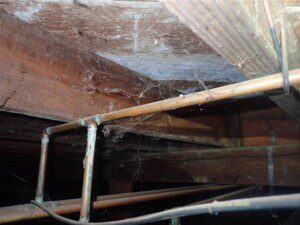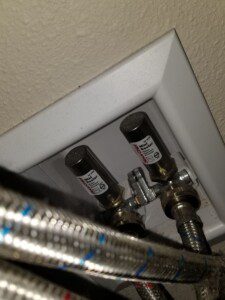
Water inside distribution pipes are under constant pressure, with most homes being between 40 – 80 pounds per square inch (psi). This pressure allows the water to travel where it needs to go in the home and pass through the fixture. If the pressure is too low, this can cause the water to come out in a trickle. If the pressure is too high, this can damage fixtures, seals, and contribute to water hammer. Water pressure usually comes from the municipal supply at the water meter at around 200 psi, which is much too high for most residential plumbing systems. To prevent problems associated with high water pressure, many homes have a water pressure-reducing valve which can be adjusted to keep water at the 40 – 80 psi range.
Water hammer occurs when a shut off valve on a high-pressure water line is abruptly closed. When this happens, the high-pressure and fast moving water has nowhere to go and slams against the side of the pipe. The pipes then move and bang against framing or other pipes, resulting the noise heard inside the home. This can damage the pipes and should be corrected to prevent potential leakage.

Hammer Arrestor
A first step to determine the extent of the problem is to check the air chamber on your plumbing system. This air chamber is usually located near the water valve and helps to prevent water hammer by creating an air cushion, which helps to absorb the shock of the water pressure. These air chambers can stop working properly if they become waterlogged and draining the plumbing system may be required. To do this, turn off the water supply at the main water shut off valve, open the faucet at the highest point in the home, and drain the water from the lowest faucet in the home. This can help to drain the water from the air chamber and fill it back up with air. If this doesn’t stop the water hammer, consider having a water hammer arrestor installed by a plumber to help create an additional cushion for the water pressure.
If your water pressure is above 80 psi, adjust the water pressure at the pressure-reducing valve to keep the pressure between 40 – 80 psi. This valve is often located near the main water shut off valve. If your pipes are loose inside the walls, securing the pipes properly can help to prevent water hammer issues.
